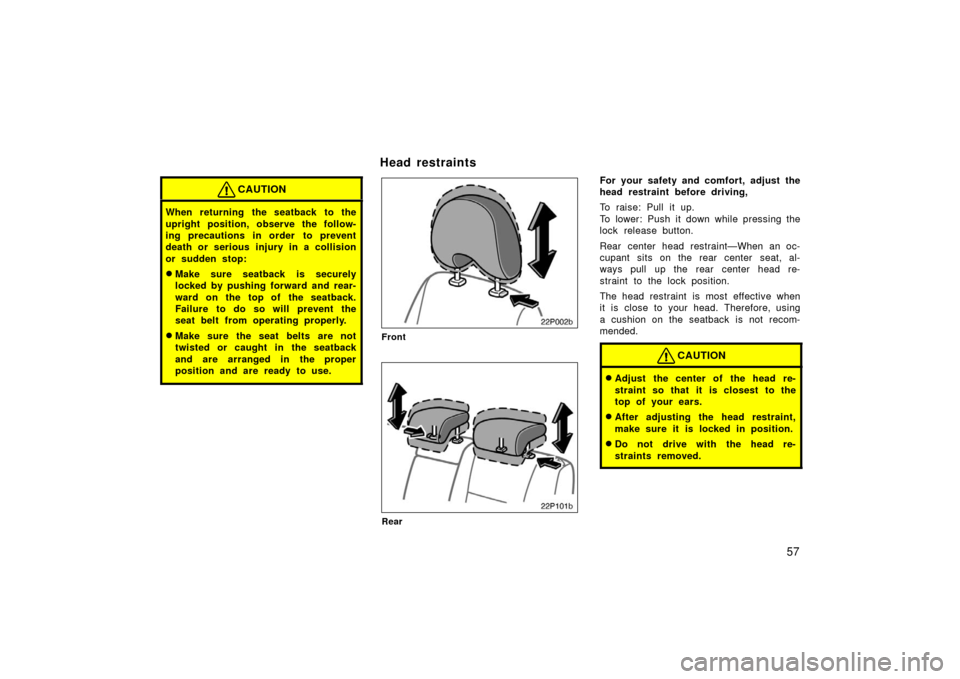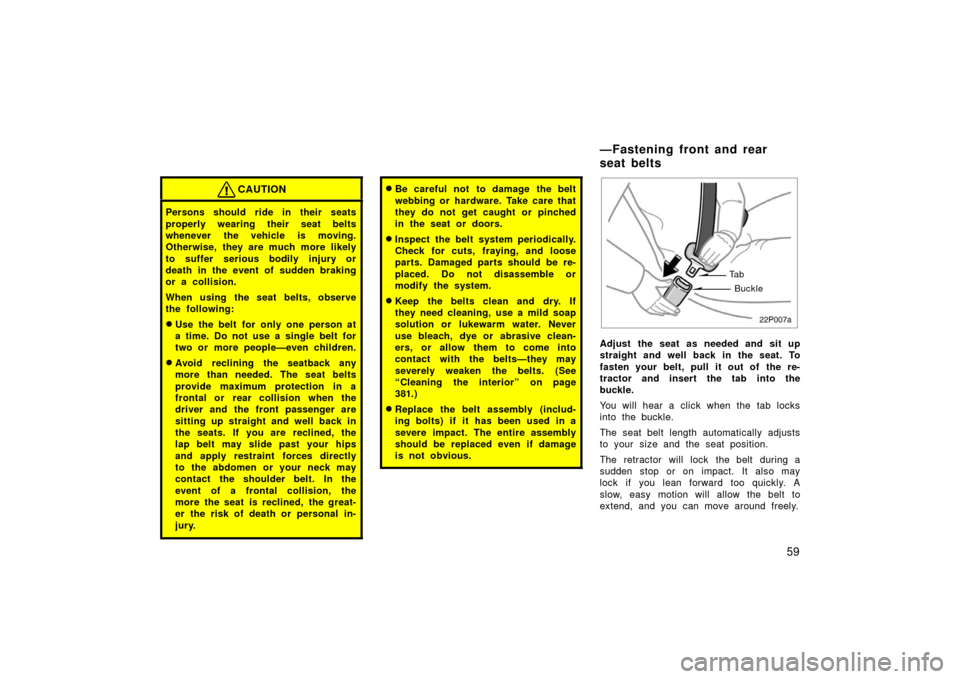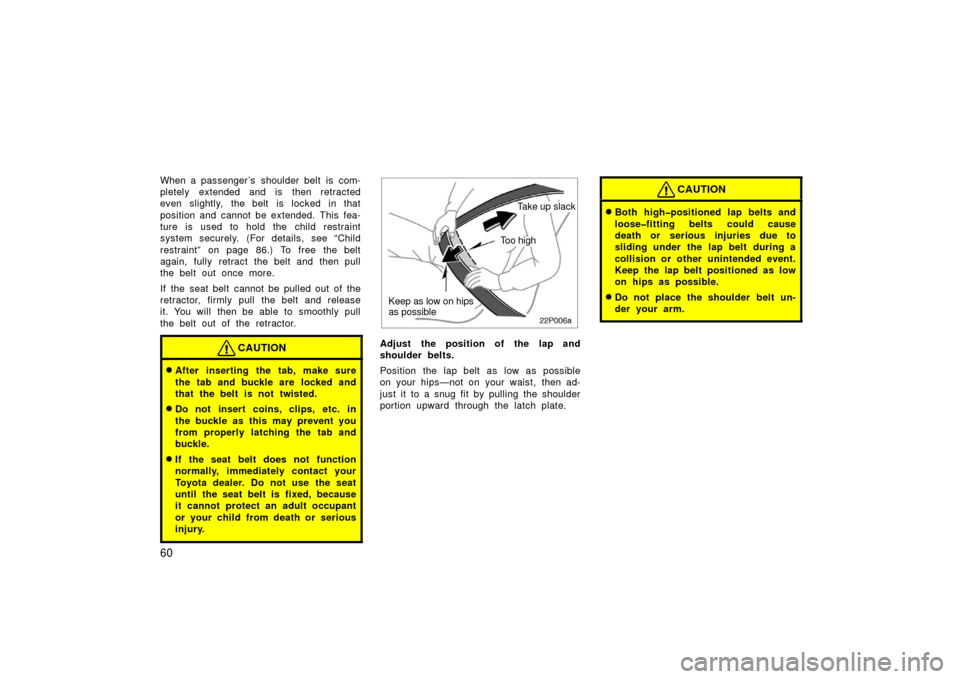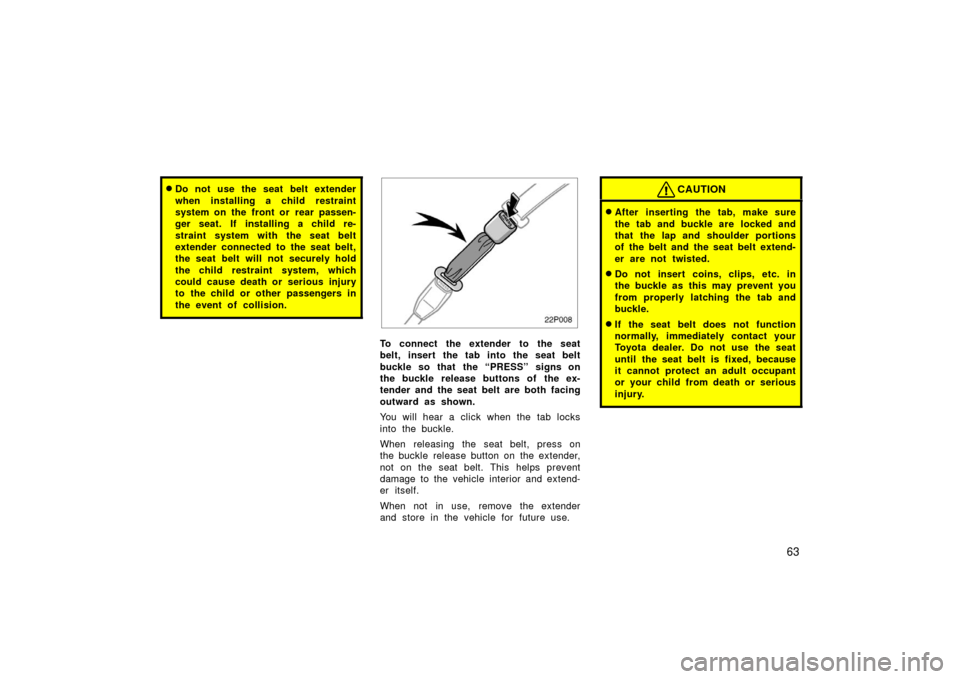Page 57 of 455

57
CAUTION
When returning the seatback to the
upright position, observe the follow-
ing precautions in order to prevent
death or serious injury in a collision
or sudden stop:
�Make sure seatback is securely
locked by pushing forward and rear-
ward on the top of the seatback.
Failure to do so will prevent the
seat belt from operating properly.
�Make sure the seat belts are not
twisted or caught in the seatback
and are arranged in the proper
position and are ready to use.
22p002b
Front
22p101b
Rear
For your safety and comfort, adjust the
head restraint before driving,
To raise: Pull it up.
To lower: Push it down while pressing the
lock release button.
Rear center head restraint—When an oc-
cupant sits on the rear center seat, al-
ways pull up the rear center head re-
straint to the lock position.
The head restraint is most effective when
it is close to your head. Therefore, using
a cushion on the seatback is not recom-
mended.
CAUTION
�Adjust the center of the head re-
straint so that it is closest to the
top of your ears.
�After adjusting the head restraint,
make sure it is locked in position.
�Do not drive with the head re-
straints removed.
Head restraints
Page 59 of 455

59
CAUTION
Persons should ride in their seats
properly wearing their seat belts
whenever the vehicle is moving.
Otherwise, they are much more likely
to suffer serious bodily injury or
death in the event of sudden braking
or a collision.
When using the seat belts, observe
the following:
�Use the belt for only one person at
a time. Do not use a single belt for
two or more people—even children.
�Avoid reclining the seatback any
more than needed. The seat belts
provide maximum protection in a
frontal or rear collision when the
driver and the front passenger are
sitting up straight and well back in
the seats. If you are reclined, the
lap belt may slide past your hips
and apply restraint forces directly
to the abdomen or your neck may
contact the shoulder belt. In the
event of a frontal collision, the
more the seat is reclined, the great-
er the risk of death or personal in-
jury.
�Be careful not to damage the belt
webbing or hardware. Take care that
they do not get caught or pinched
in the seat or doors.
�Inspect the belt system periodically.
Check for cuts, fraying, and loose
parts. Damaged parts should be re-
placed. Do not disassemble or
modify the system.
�Keep the belts clean and dry. If
they need cleaning, use a mild soap
solution or lukewarm water. Never
use bleach, dye or abrasive clean-
ers, or allow them to come into
contact with the belts—they may
severely weaken the belts. (See
“Cleaning the interior” on page
381.)
�Replace the belt assembly (includ-
ing bolts) if it has been used in a
severe impact. The entire assembly
should be replaced even if damage
is not obvious.
22p007
Ta b
Buckle
Adjust the seat as needed and sit up
straight and well back in the seat. To
fasten your belt, pull it out of the re-
tractor and insert the tab into the
buckle.
You will hear a click when the tab locks
into the buckle.
The seat belt length automatically adjusts
to your size and the seat position.
The retractor will lock the belt during a
sudden stop or on impact. It also may
lock if you lean forward too quickly. A
slow, easy motion will allow the belt to
extend, and you can move around freely.
—Fastening front and rear
seat belts
Page 60 of 455

60
When a passenger ’s shoulder belt is com-
pletely extended and is then retracted
even slightly, the belt is locked in that
position and cannot be extended. This fea-
ture is used to hold the child restraint
system securely. (For details, see “Child
restraint” on page 86.) To free the belt
again, fully retract the belt and then pull
the belt out once more.
If the seat belt cannot be pulled out of the
retractor, firmly pull the belt and release
it. You will then be able to smoothly pull
the belt out of the retractor.
CAUTION
�After inserting the tab, make sure
the tab and buckle are locked and
that the belt is not twisted.
�Do not insert coins, clips, etc. in
the buckle as this may prevent you
from properly latching the tab and
buckle.
�If the seat belt does not function
normally, immediately contact your
Toyota dealer. Do not use the seat
until the seat belt is fixed, because
it cannot protect an adult occupant
or your child from death or serious
injury.
22p006a
Take up slack
Keep as low on hips
as possible
Too high
Adjust the position of the lap and
shoulder belts.
Position the lap belt as low as possible
on your hips—not on your waist, then ad-
just it to a snug fit by pulling the shoulder
portion upward through the latch plate.
CAUTION
�Both high�positioned lap belts and
loose�fitting belts could cause
death or serious injuries due to
sliding under the lap belt during a
collision or other unintended event.
Keep the lap belt positioned as low
on hips as possible.
�Do not place the shoulder belt un-
der your arm.
Page 61 of 455
61
22p005b
Seat belts with an adjustable shoulder
anchor—
Adjust the shoulder anchor position to
your size.
To raise: Slide the anchor up.
To lower: Push in the lock release button
and slide the anchor down.
After adjustment, make sure the anchor is
locked in position.
CAUTION
Always make sure the shoulder belt
is positioned across the center of
your shoulder. The belt should be
kept away from your neck, but not
falling off your shoulder. Failure to
do so could reduce the amount of
protection in an accident and cause
death or serious injuries in a colli-
sion.
22p004a
To release the belt, press the buckle
release button and allow the belt to
retract.
If the belt does not retract smoothly, pull
it out and check for kinks or twists. Then
make sure it remains untwisted as it re-
tracts.
Page 63 of 455

63
�Do not use the seat belt extender
when installing a child restraint
system on the front or rear passen-
ger seat. If installing a child re-
straint system with the seat belt
extender connected to the seat belt,
the seat belt will not securely hold
the child restraint system, which
could cause death or serious injury
to the child or other passengers in
the event of collision.
22p008
To connect the extender to the seat
belt, insert the tab into the seat belt
buckle so that the “PRESS” signs on
the buckle release buttons of the ex-
tender and the seat belt are both facing
outward as shown.
You will hear a click when the tab locks
into the buckle.
When releasing the seat belt, press on
the buckle release button on the extender,
not on the seat belt. This helps prevent
damage to the vehicle interior and extend-
er itself.
When not in use, remove the extender
and store in the vehicle for future use.
CAUTION
�After inserting the tab, make sure
the tab and buckle are locked and
that the lap and shoulder portions
of the belt and the seat belt extend-
er are not twisted.
�Do not insert coins, clips, etc. in
the buckle as this may prevent you
from properly latching the tab and
buckle.
�If the seat belt does not function
normally, immediately contact your
Toyota dealer. Do not use the seat
until the seat belt is fixed, because
it cannot protect an adult occupant
or your child from death or serious
injury.
Page 65 of 455

65
The seat belt pretensioners are controlled
by the airbag sensor assembly. The airbag
sensor assembly consists of a safing sen-
sor and airbag sensor.
When the seat belt pretensioners are acti-
vated, an operating noise may be heard
and a small amount of non−toxic gas may
be released. This does not indicate that
a fire is occurring. This gas is normally
harmless.
Once the seat belt pretensioners have
been activated, the seat belt retractors
remain locked.
CAUTION
Do not modify, remove, strike or open
the seat belt pretensioner assemblies,
airbag sensor or surrounding area or
wiring. Failure to follow these instruc-
tions may prevent the seat belt pre-
tensioners from activating correctly,
cause sudden operation of the system
or disable the system, which could
result in death or serious injury. Con-
sult your Toyota dealer about any re-
pair and modification.
NOTICE
Do not perform any of the following
changes without consulting your
Toyota dealer. Such changes can in-
terfere with proper operation of the
seat belt pretensioners in some
cases.
� Installation of electronic devices
such as a mobile two�way radio,
cassette tape player or compact
disc player
� Repairs on or near the front seat
belt retractor assemblies
� Modification of the suspension sys-
tem
� Modification of the front end struc-
ture
� Attachment of a grille guard (bull
bar, kangaroo bar, etc.), snowplow,
winches or any other equipment to
the front end
� Repairs made on or near the front
fenders, front end structure or con-
sole
22p010a
This indicator comes on when the “IG�
ON” mode is enabled. It goes off after
about 6 seconds. This means the seat
belt pretensioners are operating proper-
ly.
The warning light system monitors the air-
bag sensor assembly, front airbag sen-
sors, side and curtain shield airbag sen-
sors, curtain shield airbag sensors,
driver ’s seat position sensor, driver ’s seat
belt buckle switch, front passenger occu-
pant classification system and indicator
light, front passenger ’s seat belt buckle
switch, seat belt pretensioner assemblies,
interconnecting wiring and power sources.
(For details, see “Service reminder indica-
tors and warning buzzers” on page 125.)
Page 89 of 455
89
22p034c
(A) INFANT SEAT INSTALLATION
An infant seat must be used in rear�
facing position only.
22p018c
CAUTION
�Never install a rear�facing child re-
straint system on the front passen-
ger seat even if the front passenger
occupant classification indicator
light indicates “OFF”. In the event
of an accident, the force of the rap-
id inflation of the front passenger
airbag can cause death or serious
injury to the child if the rear�facing
child restraint system is installed
on the front passenger seat.
22p045e
�Do not install a child restraint sys-
tem on the rear seat if it interferes
with the lock mechanism of the
front seats. Otherwise, the child or
front seat occupant(s) may be killed
or seriously injured in case of sud-
den braking or a collision.
�If the driver ’s seat position does
not allow sufficient space for safe
installation, install the child re-
straint system on the rear right
seat.
—Installation with 3�point
type seat belt
Page 90 of 455
90
22p037c
1. Run the lap and shoulder belt throughor around the infant seat following the
instructions provided by its manufactur-
er and insert the tab into the buckle
taking care not to twist the belt. Keep
the lap portion of the belt tight.
CAUTION
�After inserting the tab, make sure
the tab and buckle are locked and
that the lap and shoulder portions
of the belt are not twisted.
�Do not insert coins, clips, etc. in
the buckle as this may prevent you
from properly latching the tab and
buckle.
�If the seat belt does not function
normally, it cannot protect your
child from death or serious injury.
Contact your Toyota dealer immedi-
ately. Do not install the child re-
straint system on the seat until the
seat belt is fixed.
22p038c
2. Fully extend the shoulder belt to put itin the lock mode. When the belt is
then retracted even slightly, it cannot
be extended.
To hold the infant seat securely, make
sure the belt is in the lock mode before
letting the belt retract.